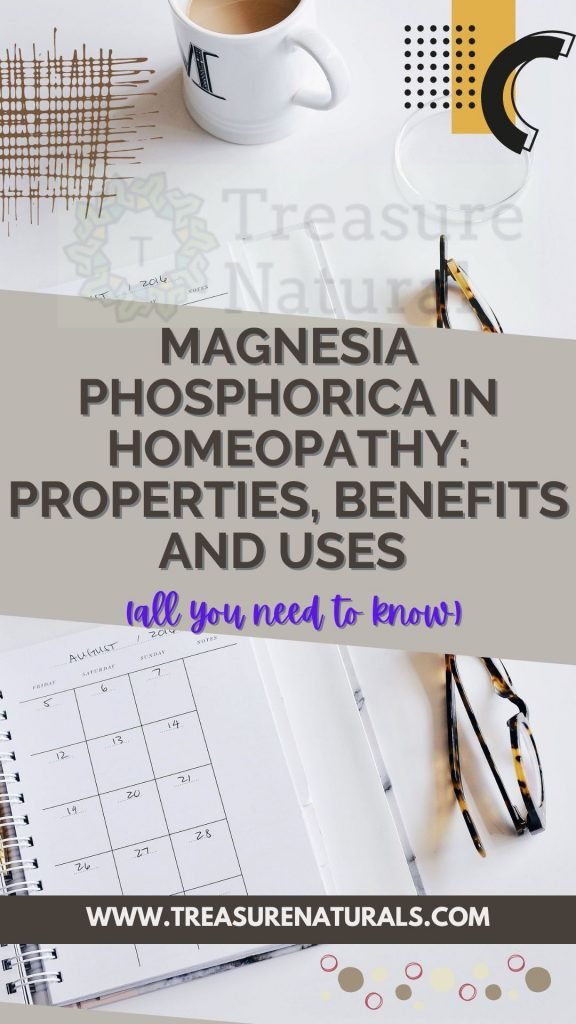
Magnesia phosphorica is a homeopathic remedy derived from magnesium phosphate. It is mainly used for the treatment of diseases that affect the nerve endings of the muscles and the muscle tissue itself, such as cramps, spasms, neuralgia and a strong sense of constriction.
Magnesium and Magnesium phosphate
Magnesium phosphate is the magnesium salt of phosphoric acid. It is a widely used acidifying product, even in conjunction with other additives.
Magnesium phosphate is used as an emulsifier, as an adjuvant of antioxidant compounds and as an “anti-lump”.
It is also used as a magnesium salt in functional foods and as a food supplement. It can also be part of the substances present in some bakery products.
In any case, it is good to remember that its use is limited to avoid a calcium deficiency.
Magnesium, on the other hand, in its pure state is a shiny and silvery mineral that becomes opaque in the air due to oxidation. This mineral, highly flammable, makes up about 2.3% of the earth’s crust in the form of different compounds (carbonates, oxides, sulfates, silicates and chlorides).
Its properties promote physical well-being: in fact, it is able to prevent numerous health disorders and promote a wide range of biological functions that involve the whole body such as muscles, nerves, digestive and cardiac systems.
Magnesium helps to lower blood pressure and restore the balance of the nervous system. Since our body is not able to produce magnesium on its own, it is necessary to take it through a healthy and balanced diet.
Magnesia phosphorica: homeopathic remedy
The homeopathic preparation of Magnesia phosphorica is obtained by shredding the element. Magnesia phosphorica has a very important action on the central nervous system, peripheral nerves and muscles. In addition, the remedy acts on a cellular level: it harmonizes the metabolism and has a balancing effect on muscle tone, because it is able to dissolve cramps and blockages, often causing nervous disorders and states of exhaustion.
The remedy is therefore mainly used in cases of:
- dysmenorrhea, with pains that decrease in intensity with the onset of flow
- night pains that improve with heat or pressure
- states of intense nervous hereticism with a tendency to seizures
It is indicated: in acute and chronic cases, in children, in excitable subjects who have a very animated mimicry and gestures but at the same time rather slow from an intellectual point of view and predisposed to spasms and neuralgia.
Magnesia phosphorica in case of dymenorrhea
Menstruation is the phase of the menstrual cycle in which blood flow is present. This phase (called menorrhea) comes from the expulsion of that surface layer of the endometrium that is formed throughout the cycle.
The menstrual phase is often accompanied and preceded by a huge corollary of symptoms that can vary from woman to woman, as they are very subjective. In particular, the set of symptoms that precede menstruation is part of the so-called premenstrual syndrome. Not all women suffer from it but it is a very frequent disorder characterized mainly by emotional phenomena. During this phase, in fact, the woman suffers from anxiety, irritability, mood instability and nervousness.
Dysmenorrhea, on the other hand, is the pain, more or less acute, that precedes and / or accompanies menstruation. It is usually localized in the pelvic and abdominal region and is accompanied by general malaise and vascular disorders.
This disorder is also very subjective and not all women suffer from it, but despite this it is still very frequent so much so that it affects 80% of women with menstruation.
Being an extremely personal disorder it is difficult to identify a triggering cause, but often it derives from ovarian dysfunctions, alterations of the uterus or hormonal imbalances.
In case of pathologies related to the gynecological sphere, Homeopathy can represent an interesting solution. For example, Magnesia phosphorica is useful precisely in case of dysmenorrhea when there is a strong crampoid pain that can begin before the actual menstruation. In this case the cramps and spasms are accompanied by a feeling of stiffening and worsen at night and in the cold.
Magnesia phosphorica: constitutional type
The constitutional subject Magnesia phosphorica usually has a dark complexion, is tired, emaciated and has a very nervous temperament.
Here are its main symptoms:
General symptoms
They are part of the general symptoms: colic, chorea, scribe cramp, dysmenorrhea, migraine, toothache, neuralgia, sciatica.
Local Symptoms
- Head: headache worsened by cold, right facial N. neuralgia, odontalgia
- Gastrointestinal: abdominal colic that improves by drinking hot liquids, abdominal pain in general, improved by bending in two
- Urogenital: dysmenorrhea improved by heat and pressure.
Mental Symptoms
Among the most common mental symptoms are irritability and hypersensitivity.
Finally the symptoms worsen with the cold, with cold baths, with cold air and on the right side; on the contrary, they improve with heat, with local pressure and with massage.






